ASM Metals HandBook Vol. 8 - Mechanical Testing and Evaluation
Подождите немного. Документ загружается.

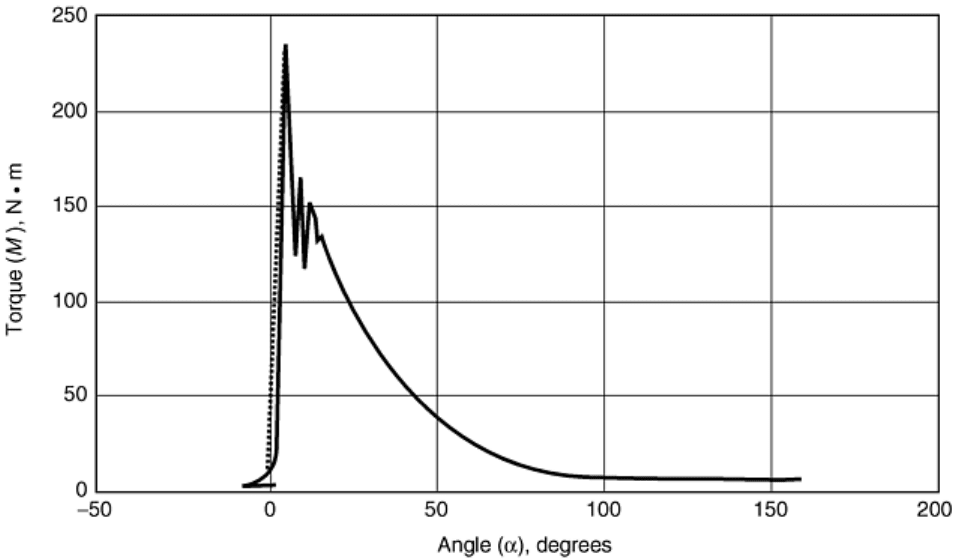
gage bolts or force washers, where the clamp force is measured along with the torque and angle during
tightening, verify that this theory is correct for a given fastener.
Figure 42 shows a release-angle study performed on an automotive wheel nut. A tool with a torque and angle
sensor connected to a transient recorder is used to loosen the nut, record the torque and angle values, and plot
the data. The resulting printed curve shows an extremely high release torque. The high initial breakaway
loosening peak torque region is disregarded because it is simply an indication of the static torque required to
start loosening motion. The high value of release torque is significant from the point of view that it illustrates
the high thread friction due to thread-pitch distortion on the wheel nut, a factor that helps prevent vibratory
loosening on typical wheel nuts.
Fig. 42 Wheel nut-loosening signature
The elastic release angle for the wheel nut shown in Fig. 42 is approximately 40°. The nut had been tightened to
a peak torque of 206 N · m (152 lbf · ft), which is 75 N · m (52 lbf · ft) greater than the vehicle manufacturer
specification. The wheel nut was originally tightened to a torque of 160 N · m (118 lbf · ft), which did not
appear to get past the tightening alignment zone as illustrated by the signature shown in Fig. 43. In this
example, high underhead friction limited the tension on the stud, which for normal friction conditions, would
have resulted in stud yield or fracture due to overelongation.
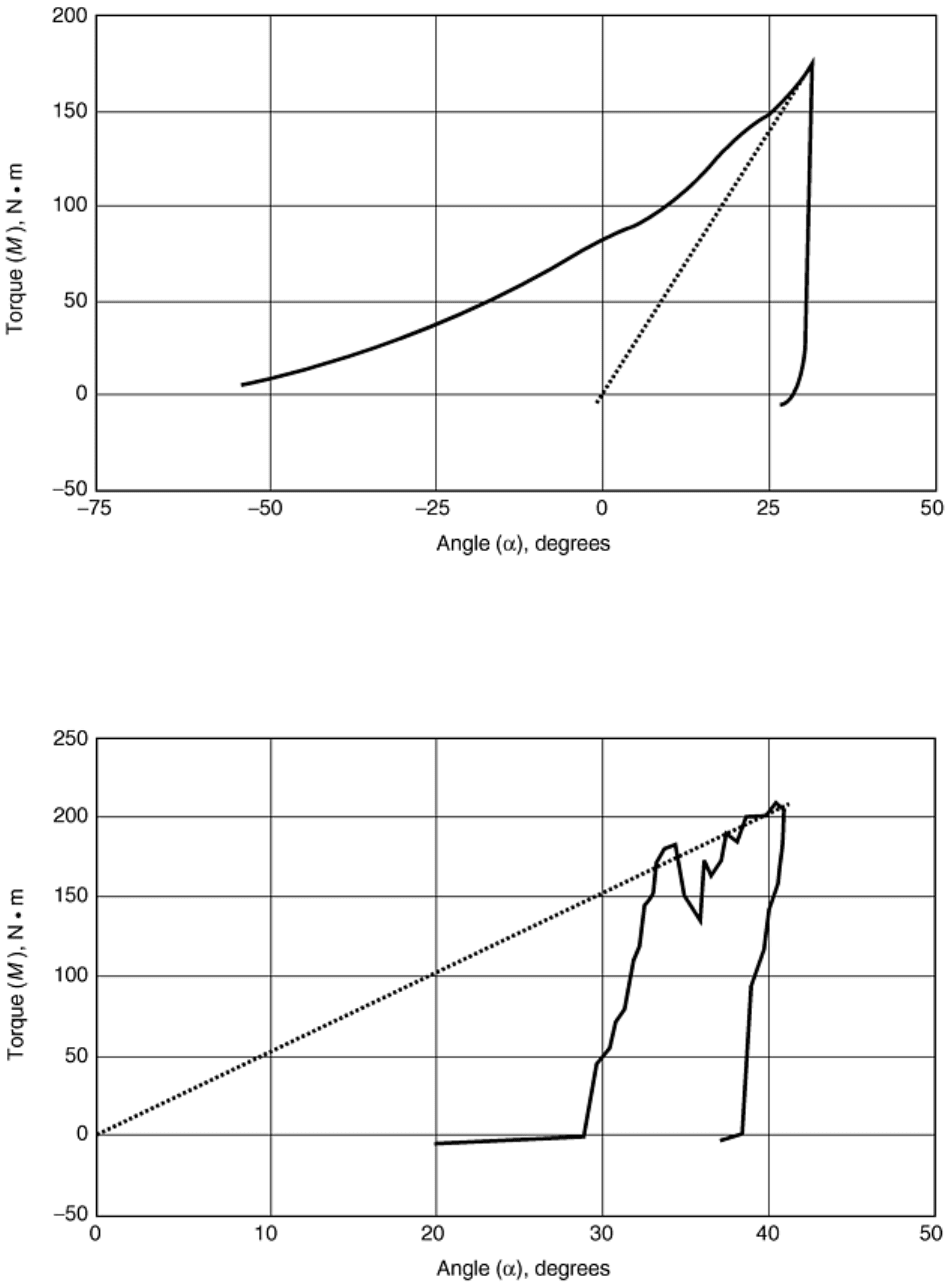
Fig. 43 Wheel nut-installation signature
The installation was followed by a hand-torque breakaway audit where the nut was advanced about 7 or 8° in
the tightening direction, as shown in Fig. 44. The torque-angle diagram for the audit shows that the final torque
was about 206 N · m (152 lbf · ft), with a projected elastic-tightening angle of 40°.
Fig. 44 Wheel nut-torque audit signature
Applying the release-angle method, a line is projected tangent to the elastic release portion of the curve to zero
torque. This release angle, measured from the release-torque point to the point where the tangent line crosses
the zero torque or prevailing torque level, is directly proportional to the tension or clamp force released. In
comparing Fig. 44 with Fig. 42, a significant correlation is seen to exist between the release angle determined
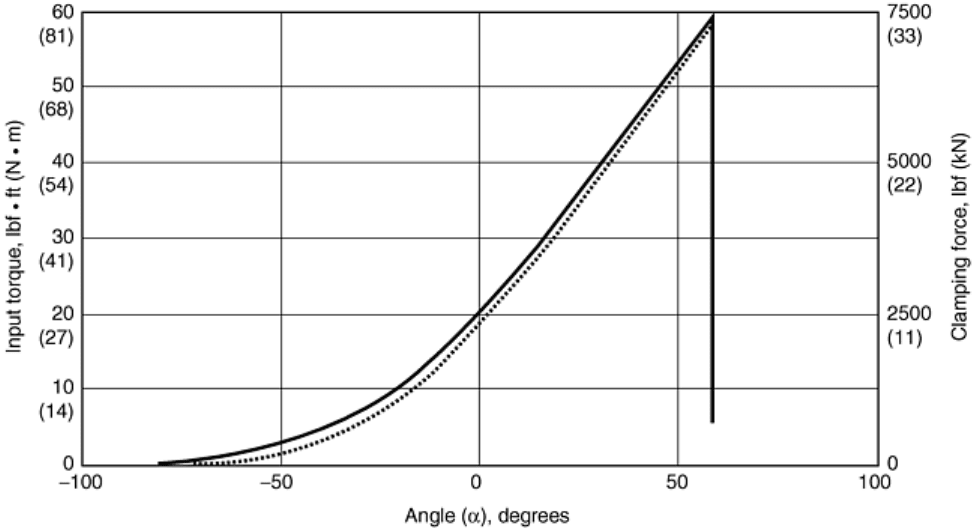
by loosening the fastener and the torque-angle diagram as applied to the torque-angle signature for the
breakaway audit. The loosening signature in Fig. 42 was recorded after the audit plotted in Fig. 44.
Torque-Angle Tension Audits
Torque-angle signature analysis is particularly useful for studying all critical fastener assemblies where, in
terms of safety or reliability, it is important that proper preload is initially obtained and maintained throughout
the operating life of an assembly. In addition to analyzing fastener problems, such as loosening and
embedment, torque-angle signature analysis can also be used to evaluate the performance of tightening tools in
applying the desired clamp force on fasteners. This technique is particularly applicable for evaluating processes
that employ pulse tools and impact tools.
Due primarily to ergonomic considerations, pulse tools have recently been widely specified for use in high-
volume assembly operations. Unfortunately, the limitations of these tools related to their energy transfer
characteristics are not generally well understood. Pulse and impact tools are particularly sensitive to joint rate
and friction variations. Because friction coefficients are a function of velocity as well as surface pressure,
tightening results with pulse, and high-rpm tools must be carefully evaluated to ensure suitable tightening
process capability.
For example, pulse and impact tools move fasteners at high speeds with a great deal of stick-slip, chatter, and
unique frictional characteristics that are not seen with steady, continuous tightening processes. These factors
can lead to a deceptively high torque reading but with minimal clamp force created. By checking the assembled
joint with an audit method that can correlate angle of turn and clamp load, the user can ensure that the assembly
is securely tightened.
The following series of tightening, breakaway-torque audits and release signatures illustrate the basic concepts
of torque and tension audit using torque-angle signatures. Understanding of the engineering mechanics of
threaded fasteners is greatly enhanced through the use of the concept of the elastic origin and the application of
torque-angle (M-alpha) and tension-angle (F-alpha) diagrams to the audit process.
Tightening Curve Analysis. In the example illustrated in Fig. 45, an M12 × 1.75 fastener was tightened to 80 N
· m (60 lbf · ft). The signature was recorded with a recording threshold of 27 N · m (20 lbf · ft). The plot shows
both torque and tension versus angle of turn, with zero angle located at the threshold.
Fig. 45 Torque and clamp load vs. angle
The signature analysis software used in this analysis can automatically locate the elastic origin on the torque-
angle diagram by projecting a tangent line from the final point on the torque-angle curve to the zero torque
level. The torque-angle diagram for the installation-tightening signature, shown in Fig. 46, illustrates that the
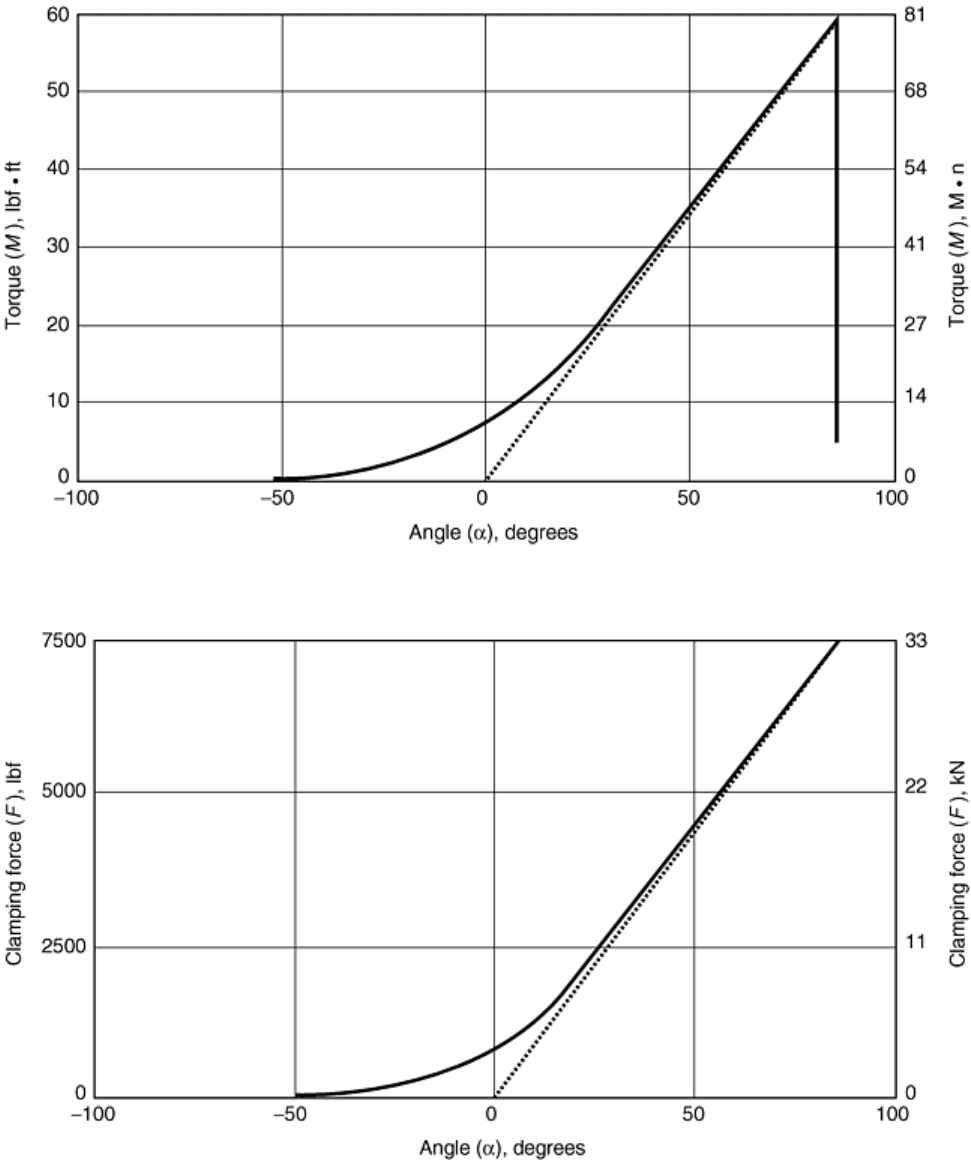
torque resulted in a projected elastic tightening angle of approximately 85°. The corresponding tension-angle
curve, shown in Fig. 47, confirms the relationship between torque and angle with the concept of the elastic
origin. Note that the 85° elastic tightening angle for the bolt results in a clamping force of approximately 33.4
kN (7500 lbf).
Fig. 46 Torque-angle diagram for installation tightening signature
Fig. 47 Clamp force vs. angle diagram corresponding to the torque-angle diagram in Fig. 46
Breakaway Analysis. The next signature is the breakaway torque audit (Fig. 48) on the bolted joint tightened
for the example shown in Fig. 43 44 45. Breakaway hand-torque audits are often used in an attempt to correlate
the dynamic installation torque with the measured breakaway point. In this example, the fastener was torqued in
the tightening direction until an additional angle of turn of approximately 12 to 13° was attained. Note that the
head of the fastener started to move at approximately 74.5 N · m (55 lbf · ft). The actual breakaway point and
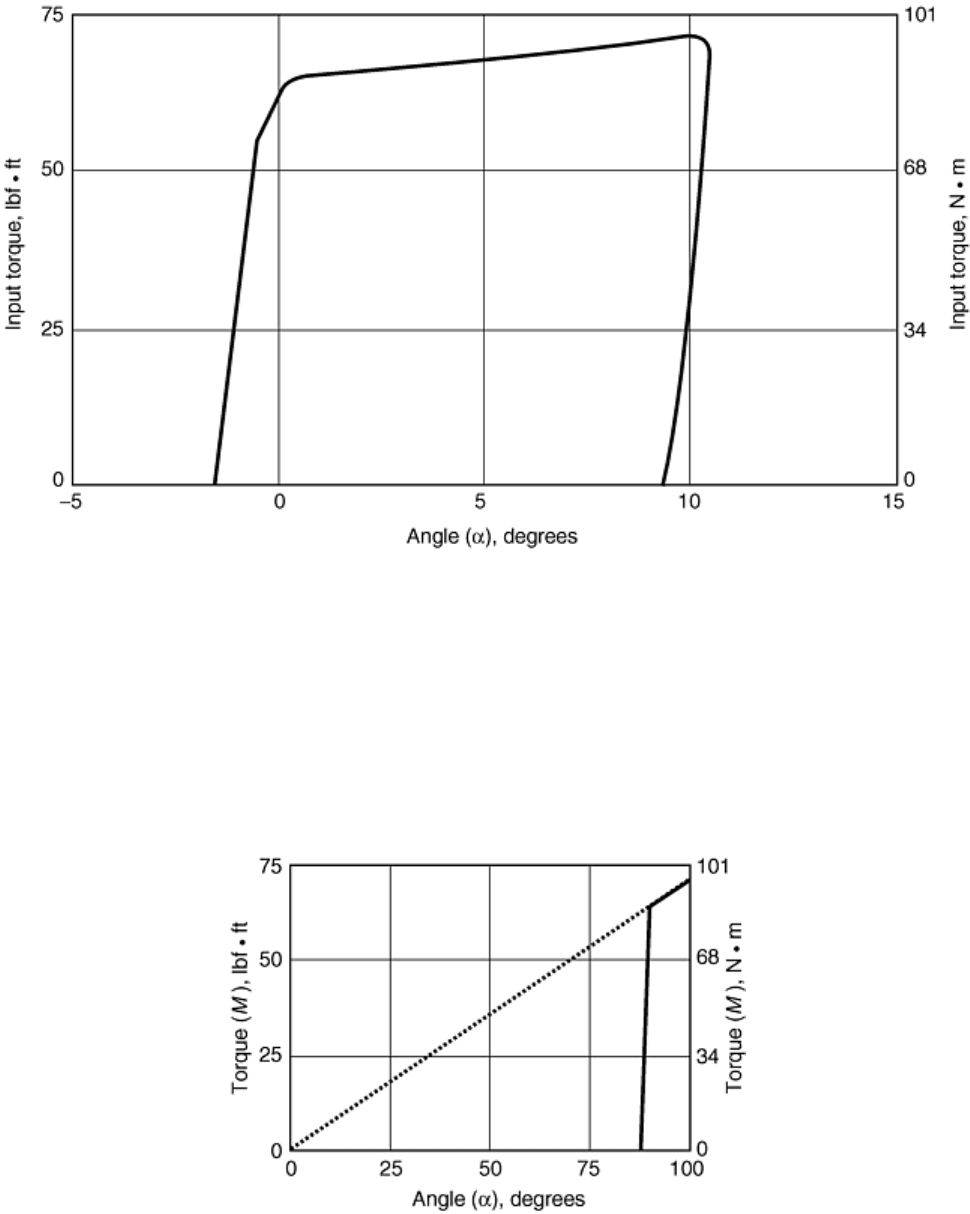
continuation of the tightening process occurred at approximately 88 N · m (65 lbf · ft) of applied torque. These
observations confirm the installation torque of 81 N · m (60 lbf · ft) as is normally done for a breakaway torque
audit.
Fig. 48 Breakaway torque audit on the bolted joint tightened for the example shown in Fig. 43 44 45
The signature analysis diagram shown in Fig. 49 is one of the most significant analysis tools developed in the
past 10 years. This diagram shows how it is possible to audit both the installation torque and correlate the
signature of the audit curve directly with fastener tension. The projection of the tangent to the torque-angle
signature curve that locates the elastic origin is the key to significant improvement of the hand-torque audit
process. The torque-angle diagram for this audit signature clearly shows the torque breakaway point related to
the installation torque, as well as the 85° initial tightening angle, which correlates with a preload of 33.4 kN
(7500 lbf) clamping force. Note that the breakaway audit increased the tightening angle to approximately 95 to
100° projected from the elastic origin, with an expected proportionate increase in preload.
Fig. 49 Breakaway torque audit showing the torque breakaway point related to the installation torque
Release-Angle Audit. If the torque-angle signature is recorded when a fastener is loosened, as shown in Fig. 50,
the resulting release-angle graph can be used to determine the elastic tightening angle and, thus, directly
estimate the approximate fastener tension that was released, provided the tension-angle slope for the joint has
been established.
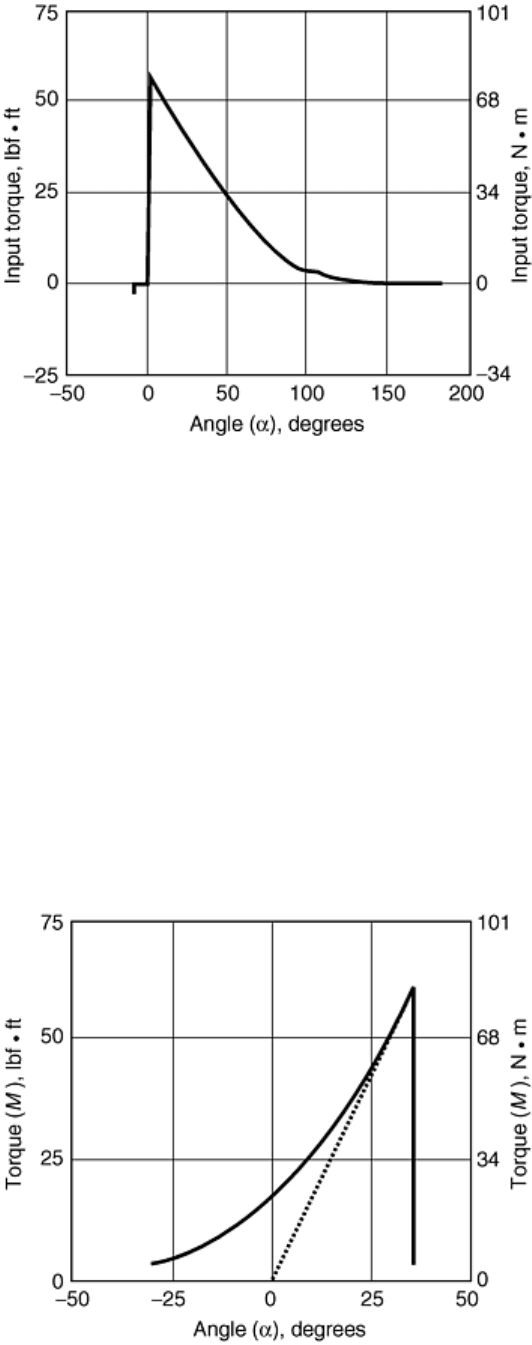
Fig. 50 Release angle signature
Torque-angle plots and release-angle plots can be used to directly estimate bolt tension, or preload, which is the
ultimate goal of the fastener-tightening process. The release angle of approximately 95° in the example shown
in Fig. 50 confirms the tightening angle measured on the torque-angle diagram for the hand-torque audit.
Clearly, the release-angle method of audit provides a direct measure of the capability of a given tool to develop
tension in the tightened fastener.
Frictional Analysis Audits. To provide an example of how audit techniques can be used to the effect of
differences in frictional characteristics, the fastener type used in the previous examples (Fig. 43, 44, 45, 46, 47,
and 48) was stripped of all thread and underhead lubricants to create higher friction coefficients in the thread
and underhead regions. The torque-angle diagram for tightening to 81 N · m (60 lbf · ft), shown in Fig. 51,
indicates a tightening angle of only 25° projected from the elastic origin. Compared with the lubricated fastener,
where the tightening angle was 85°, the predicted preload of 9786 N (2200 lbf) was confirmed by the clamp-
force measurement. The breakaway audit for the dry-tightened fastener (Fig. 52), confirms that the installation
torque was approximately 81 N · m (60 lbf · ft) and also reveals the expected very low angle of turn from the
elastic origin.
Fig. 51 Torque-angle diagram for a fastener stripped of all thread and underhead lubricants, tightened
dry

Fig. 52 Breakaway torque-angle audit for the dry-tightened fastener
Application of Torque-Angle Signature Analysis
The torque-angle signature method of analysis applied to tightening and loosening curves is plain, simple, and
straightforward. It is a basic engineering analysis technique using fundamental stress, deflection, and material
strength properties to model and measure the bolted-joint tightening process. Torque angle signatures can be
analyzed to determine installation torque, thread strip, underhead embedment, bolt yield, and most importantly,
fastener tension. While there are many factors that can alter the tightness of a given bolted joint, the torque-
angle signature analysis method provides a practical method for direct verification of clamp force to assure a
quality fastener assembly. The technique can be applied to fasteners of all sizes and all grip lengths.
The release-angle signature, when compared to the installation-torque angle, can be used to evaluate the clamp
load retained after a dynamic test. Material creep and embedment phenomena, which lead to loss of preload, are
readily analyzed and quantitatively evaluated through the use of release-angle analysis methods. The results of
release-angle audits, being directly related to the achieved tension, are significantly more meaningful than the
torque magnitudes obtained from breakaway torque audits. An improved version of the breakaway torque audit,
which uses the torque-angle signature of the audit, can be used to directly estimate fastener tension. This
analysis process correlates precisely with the release-angle-signature method. The only limitation is that the
breakaway audit must be conducted in the elastic tightening region for the bolted joint where bolt yield or
thread strip are not present.

Mechanical Testing of Threaded Fasteners and Bolted Joints
Ralph S. Shoberg, RS Technologies, Ltd.
Measurement Accuracy
It is important that all standards for fasteners be reviewed in regard to the specification for measurement
accuracy. The specification of measurement accuracy for torque and clamp force should be in compliance with
the ISO 25 methods used by the American Association for Laboratory Accreditation (A2LA) in the certification
of laboratories. Both torque and clamp-force measurement specifications should refer to accuracy at the point of
measurement. It is desirable to certify the accuracy and uncertainty of dynamic measurements at the real-time
testing speeds (i.e., rpm) that are required by each test specification.
The following paragraphs of this section illustrate some examples of the accuracy specifications found in
current standards that need to be reviewed and perhaps changed or revised. It is hoped that future revised
editions of existing standards and all new standards will give proper attention to understanding the science of
measurements and the capability of current state-of-the-art measurement equipment. From a practical point of
view, it is also important to consider the true need of accuracy so that unnecessarily tight tolerances are not
specified. This is especially true where broader tolerances that are capable of properly meeting the desired end
result can be demonstrated as sufficient to qualify the measurement with regard to its intended purpose.
Defining the Measurement
All measurements are comparisons to standards, and practically no measurement is without a degree of
uncertainty. To be valid, a measurement must have an unbroken chain of traceability to well-defined,
established primary standards. Each step of the traceability chain introduces additional uncertainty, which has a
cumulative effect on the accuracy and uncertainty of the final measurement.
It should be recognized that the accuracy of a measurement cannot be any better than the resolution of the
measurement system. For most practical purposes, the measurement system resolution is defined as the smallest
increment displayed on the measurement dial, such as the scale on a torque wrench or the pressure read on a
hydraulic load-indicating gage. In digital electronic measurement systems, the smallest increment for the
analog-to-digital (A/D) converter establishes the basic measurement resolution.
U.S. Standards
The American Society of Mechanical Engineers (ASME), the Society of Automotive Engineers (SAE), ASTM,
the American National Standards Institute (ANSI), and the Industrial Fasteners Institute (IFI) all have
established fastener standards in the United States. However, to meet the needs of a global economy where
products manufactured in the United States can be marketed worldwide, it is important to recognize that a large
amount of effort may be necessary to align U.S. testing standards with the international marketplace.
Significant progress has been made in the conversion of U.S. manufacturing to the metric (Système
International d'Unites) (SI) system. Recognizing the United States' continued slow progress in this matter, the
European commission has recently delayed the mandatory metric-only labeling requirement from 31 Dec 1999
to the year 2010.
International Standards
The European Committee for Standardization (CEN) centralizes the establishment of standards for the
European Union (EU) member nations. By coordinating U.S. testing standards with those approved by CEN, it
will then be possible to avoid or at least minimize any costly duplicate testing on products intended for sale to
customers in EU member countries.
One area in which the United States needs to address serious deficiencies is in its method of definition of
accuracy with regard to the test measurement procedures specified by U.S. standards. A number of U.S.
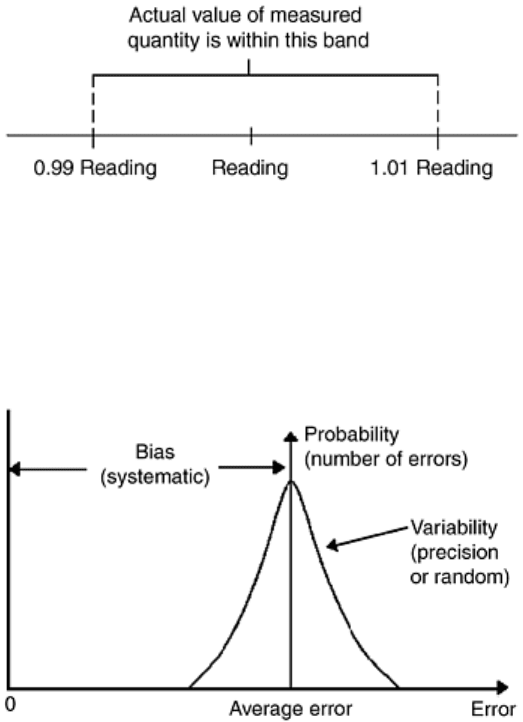
standards contain specifications that are obsolete, impractical, or not precise enough to be acceptable when
subjected to the qualifying analysis applied to European testing methods.
For a number of years, many U.S. companies have been striving to become world class manufacturers with
certification to ISO 9002. Fastener testing that meets the requirements of ISO/International Electrotechnical
Commission (IEC) 25, titled “General Requirements for the Technical Competence of Calibration and Testing
Laboratories,” would qualify to meet the requirements of ISO 9002. Failure to specify accuracy and uncertainty
of measurements in a manner consistent with ISO 25 requirements will very likely make testing unacceptable
for product sales to the European community.
Definitions of Accuracy
Accuracy can be defined only in terms of the entire measuring system and the environment, pertaining to both
the instrumentation and the physical nature of the phenomena to be measured. Measurement accuracy is
dependent on the capability of the measuring system to dynamically track the signal (frequency response) and
provide sufficient resolution to permit comparison to be made between readings. Because a measurement
reading is always an approximation of the true value, the uncertainty quantifies the limits of accuracy that can
be expected. In the example illustrated in Fig. 53, the stated accuracy is 1% of the reading.
Fig. 53 Range of accuracy
Measurement Error
There are two general components of measurement error, bias and random. Bias is a constant value, such as a
zero offset of a transducer or measuring amplifier, or a digital reference point. The random component is a
complex function of system noise or the least-bit resolution in digital systems (Fig. 54).
Fig. 54 Nature-of-measurement error
Frequency response effects where the phenomena measured may occur dynamically in a region beyond the flat
response of the measurement system are not random errors. Such errors are the result of poor measurement
system performance resulting from improper understanding of the engineering physics of the process being
measured.
Measurement Error Observations. Measurement errors of a random nature typically have a normal distribution
as shown in Fig. 55. To evaluate a measurement system, it is necessary to input constant known values and
determine the scatter in the measurements over a number of samples. Statistics, such as sample standard
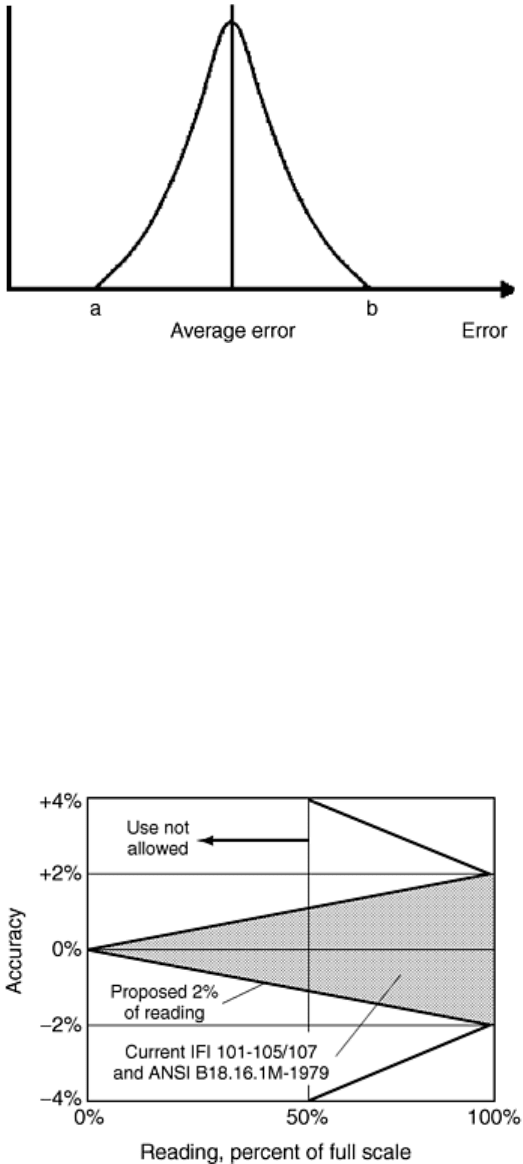
deviation, can be used to quantify the probability function for the readings that define the uncertainty for the
test conditions simulated.
Fig. 55 Measurement error observations
Allowable Uncertainty Versus Percent Full-Scale Reading
A number of currently used standards specify the accuracy of readings in terms of “percent full scale.” As
shown in Fig. 56, the 2% full-scale accuracy specification results in a 4% error at a point of reading taken at
50% of the full scale of the measuring device range (in this case, a force transducer). Similarly, the error would
extrapolate to 8% of the reading at 25% of measurement-transducer range. In an attempt to limit the error in
measurement, this standard stipulates that “transducers cannot be used below 50% of their full-scale range.” If
this stipulation is followed closely for locknut testing, the tester would need to use one set of transducers to
obtain prevailing on-torque and clamp-load values, then stop the test and use a higher capacity set of sensors to
obtain the torque at clamp load. This process would be followed by a return to the lower-range sensor to obtain
the prevailing off-torque data to complete the test. This situation is impractical at the least and impossible in
most cases. Fortunately, with properly calibrated and qualified modern testing systems and specifications based
on accuracy at the point of measurement, the complicated process described is rendered totally unnecessary.
Fig. 56 Allowable uncertainty
It is far more practical and consistent with modern testing procedures according to ISO 25 that accuracy be
specified at the point of measurement. In this example, it would be proposed that the accuracy specification be
changed to “within 2% of reading.” Taking a modern approach in revising this standard, the totally impractical
and unnecessary limitation on the use of the transducer below 50% of its full-scale range would be eliminated.
There are a number of test procedures where accuracy specifications can be adjusted to different values at
various points within the test, thus permitting a valid comparison of samples while using a single transducer
over a broad measurement range. One possible example would be testing of prevailing torque locknuts where
